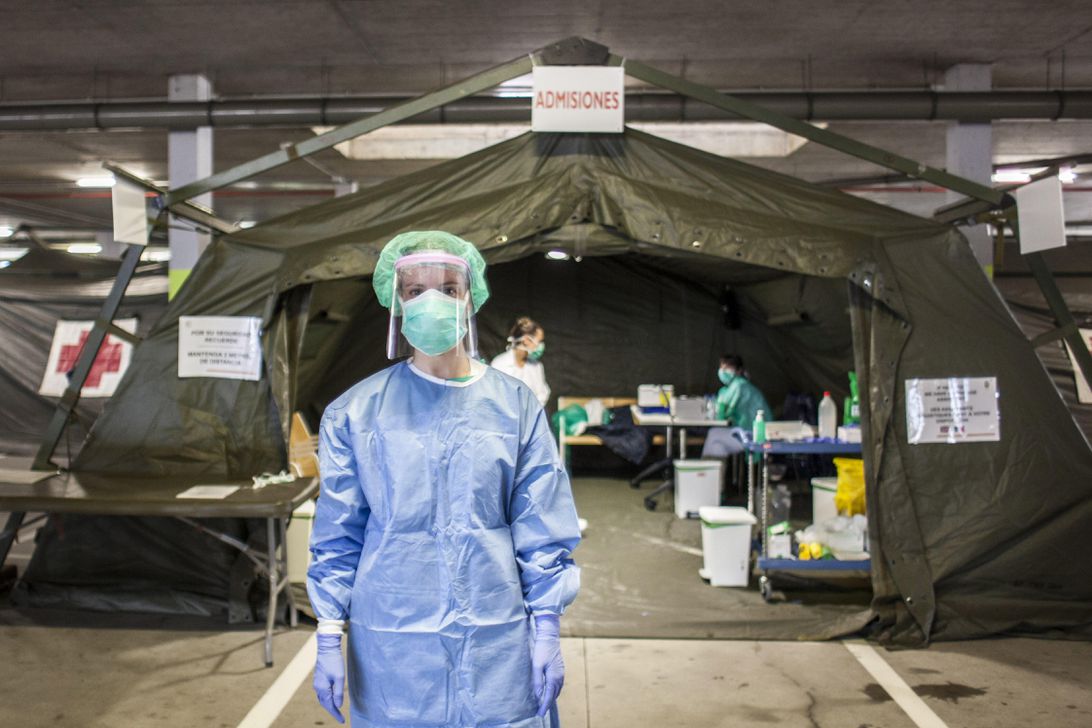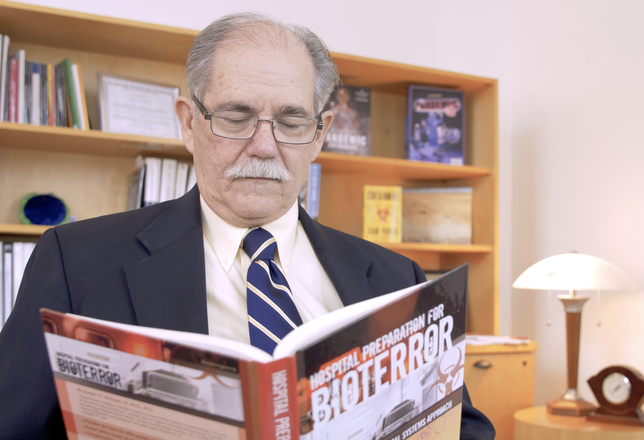'I'm scared': Johns Hopkins expert says coronavirus is totally unprecedented
With diagnosed COVID-19 cases passing 1 million worldwide and communities around the globe on lockdown, the coronavirus pandemic has claimed a place as one of the most serious public health crises in living memory, an emergency that pandemic expert Eric Toner says is "unlike anything we've seen before." Toner, of Johns Hopkins University, sat down with CNET's Claire Reilly to shed light on the scale of what the world is facing.

What we know:
- More than 54,000 people have died from COVID-19, the illness caused by the novel coronavirus (SARS-CoV-2).
- The US has the highest number of cases, outstripping China, where the virus originated, as well as secondary outbreak zones in Italy and Spain. The current global count: more than 1 million infections.
- Many countries failed to adequately prepare, according to Toner: "We in the US can't claim to be surprised."
- Unprecedented danger calls for unprecedented measures: "This is unlike anything we've seen before," Toner says. "And there is no way to completely stop this. It can't be contained, it can only be slowed down."
When unusual cases of pneumonia started appearing in Wuhan, China, at the end of 2019, medical experts didn't know what they were seeing. The virus appeared similar to SARS or bird flu, but it was a totally new strain. And it was spreading quickly.
Three months later, the coronavirus has brought the world to its knees, shutting down entire countries and causing an exponential spike in disease and death. The race is on to find a vaccine, but experts say we won't see one for at least 18 months.
Toner, a senior scientist at the Johns Hopkins Center for Health Security, has more than three decades of experience in hospital disaster planning and pandemic preparedness. He's worked with governments and public health officials during many epidemics and disasters, and he says the coronavirus is unique.

"It started to become obvious that this was something that was unprecedented in our lifetimes," Toner says. "Obviously, China was surprised; no one knew this virus existed. Italy was surprised; they didn't see it coming. We in the US can't claim to be surprised; we have seen this coming for months now."
Now that more than 5,000 Americans have died, and experts say the country could expect to see 100,000 to 200,000 or more deaths in the coming months, Toner says he's "scared."
"I think one would have to be clueless not to be scared right now," he says. "The current coronavirus pandemic is worse than many that we have anticipated in the past ... this is going to end up being a truly historically bad event."
The early outbreak in China concerned Toner and his colleagues. But on Jan. 23, when Chinese officials put the city of Wuhan on lockdown, ordering 11 million people into a citywide quarantine, Toner and his peers knew this epidemic was different. Now Toner says governments around the world should've heeded those early warning signs.
The threat from the coronavirus is how quickly it spreads and how many people it kills.
"It's just as contagious as influenza, but many times more lethal," says Toner.
According to Toner, roughly 10% to 15% of the global population is infected with influenza every year. But because COVID-19 is a new disease, and humans have no immunity to it, many more people will become infected with the coronavirus.
"Even if the case fatality rate -- the number of people who are sick and who end up dying -- is on the low end of half a percent, that would mean millions and millions of deaths," Toner says.
"Even if the case fatality rate is on the low end of half a percent, that would mean millions and millions of deaths."The danger of SARS-CoV-2 lies in the spiked proteins on the outside of the virus itself. These proteins attach to receptors in the human respiratory tract and create an opening to break into our cells. Once inside, the virus injects its genetic material and hijacks the cell, forcing that cell to create more copies of the virus.
"Then the cell explodes," says Toner. It "spews out ... thousands of times more virus that go on in a chain reaction, going from cell to cell, with ever increasing numbers of virus, ever increasing numbers of damaged cells. Our lungs become inflamed; they swell; they fill with fluid. And in severe cases, [the virus ends] up killing people because their lungs fail."
But there's also hope. Researchers and biotech firms are moving at an unprecedented pace to develop vaccines against the coronavirus, using the virus' genetic code to try to stimulate an immune response in uninfected patients. Other researchers are analyzing the blood of patients who've recovered from COVID-19, in the hope that their immunity can be transferred to other people.
"Technology is revolutionizing the way in which we can make drugs and vaccines -- to do it much faster than we could ever do it before," he says. "So even though it will certainly be at least a year or two before we have a vaccine, this would be the first time we've ever had a vaccine for an emerging infectious disease. In the past, it took so much longer."
Until we have treatments for the disease (which could take three to six months) or a vaccine (which could take one to two years) the solution to fighting this pandemic is decidedly lo-fi: Stay at home.
"There is no way to completely stop this," says Toner. "It can't be contained. It can only be slowed down. But slowing it down is essential and requires an unprecedented level of action.
"We all have to band together to do social distancing, to adhere to these really difficult public health interventions that are changing our lives so dramatically."
Toner says we shouldn't expect to get an "all clear" all at once, that any measures we take to ease the pressure on the health care system need to last longer than a few weeks to have any significant effect. Right now a third of the global population is in some form of lockdown. In the US, more than 80 percent of the population is under stay at home orders.
But ultimately, the sacrifice will help the world avoid a far greater tragedy.
"We have to do this for the good of our neighbors and our family members and our communities. If we don't, we'll see what has been seen in Italy and in China: a catastrophe that most people have trouble imagining."
You should read it
May be interested
- Coronavirus vaccines: The drugs in development to treat COVID-19
 researchers are racing to develop new treatments and therapies to tackle the coronavirus pandemic. here's what you need to know about them.
researchers are racing to develop new treatments and therapies to tackle the coronavirus pandemic. here's what you need to know about them. - Coronavirus stimulus check is official: Find out if you're eligible for up to $1,200
 the new coronavirus relief package includes cash payments to many people affected by the epidemic. here's what you need to know.
the new coronavirus relief package includes cash payments to many people affected by the epidemic. here's what you need to know. - Coronavirus $1,200 stimulus check: Find out if you're eligible
 the new coronavirus relief package includes cash payments to many people affected by the epidemic. here's what you need to know.
the new coronavirus relief package includes cash payments to many people affected by the epidemic. here's what you need to know. - Coronavirus updates: States extend lockdowns as federal social distancing guidelines pushed to April 30
 plus: dr. anthony fauci, one of the us government's top advisers on coronavirus, says covid-19 could kill 100,000 to 200,000 americans.
plus: dr. anthony fauci, one of the us government's top advisers on coronavirus, says covid-19 could kill 100,000 to 200,000 americans. - Coronavirus vaccines: Drug trials, chloroquine and treatments for COVID-19
 coronavirus vaccine candidates are already being trialled in animals and humans. plus, the cutting-edge drugs being developed to counter the pandemic.
coronavirus vaccine candidates are already being trialled in animals and humans. plus, the cutting-edge drugs being developed to counter the pandemic. - Google searches about finances spike in US amid coronavirus pandemic
 the query 'coronavirus money help' has upticked over the last month.
the query 'coronavirus money help' has upticked over the last month. - Coronavirus: How to track the spread across the world as cases top 450,000
 an online dashboard shows all confirmed, suspected and recovered coronavirus patients, as well as deaths.
an online dashboard shows all confirmed, suspected and recovered coronavirus patients, as well as deaths. - Coronavirus: How to track the spread across the world as cases top 500,000
 an online dashboard shows all confirmed, suspected and recovered coronavirus patients, as well as deaths.
an online dashboard shows all confirmed, suspected and recovered coronavirus patients, as well as deaths. - Coronavirus: How to track the spread across the world as cases top 1 million
 an online dashboard shows all confirmed, suspected and recovered coronavirus patients, as well as deaths.
an online dashboard shows all confirmed, suspected and recovered coronavirus patients, as well as deaths. - Coronavirus updates April 7 2020
 coronavirus updates plus: dr. anthony fauci says social distancing is helping, and the cdc advises people to wear nonmedical cloth face masks when venturing out.
coronavirus updates plus: dr. anthony fauci says social distancing is helping, and the cdc advises people to wear nonmedical cloth face masks when venturing out.










 Upcoming 'Pink Moon' on April 7 is the biggest supermoon of 2020
Upcoming 'Pink Moon' on April 7 is the biggest supermoon of 2020 Over 12,000 people applied to fly to the moon and Mars as NASA Artemis astronauts
Over 12,000 people applied to fly to the moon and Mars as NASA Artemis astronauts Flies having sex preserved in fossil dating back millions of years
Flies having sex preserved in fossil dating back millions of years NASA brings famous 'worm' logo out of 28-year retirement for crewed SpaceX mission to ISS
NASA brings famous 'worm' logo out of 28-year retirement for crewed SpaceX mission to ISS Deep-sea rocks on Earth spark new hope for finding life on Mars
Deep-sea rocks on Earth spark new hope for finding life on Mars Confirmed coronavirus cases hit 1 million worldwide
Confirmed coronavirus cases hit 1 million worldwide